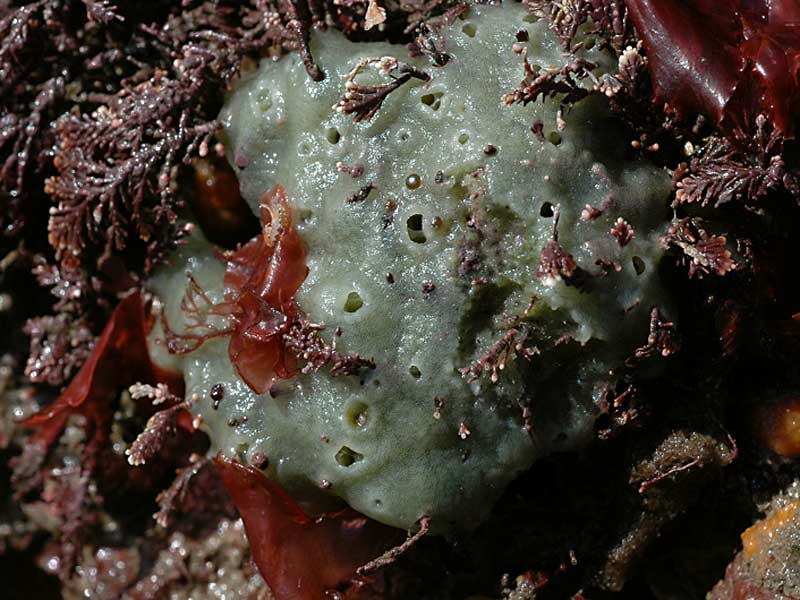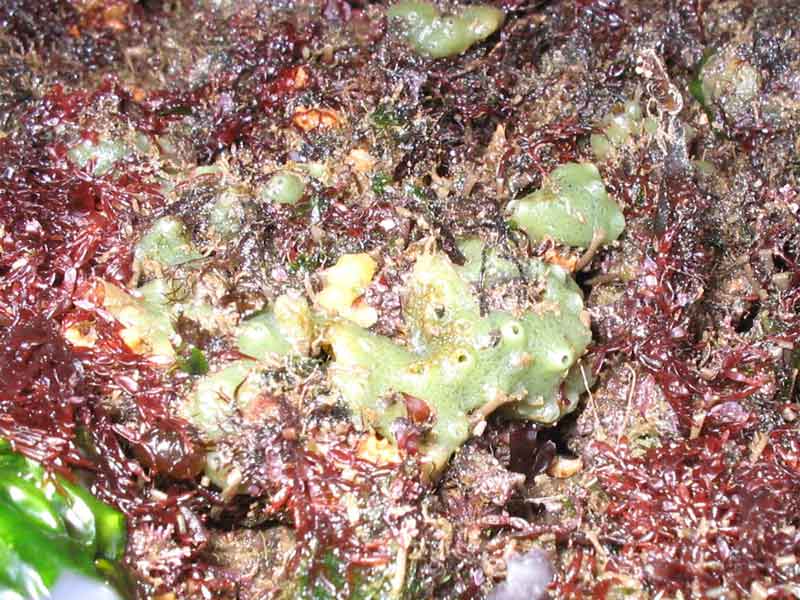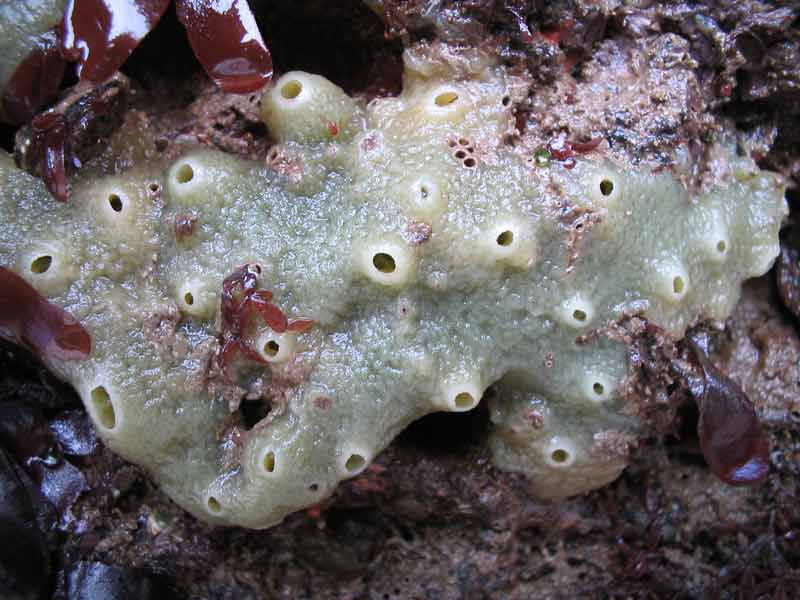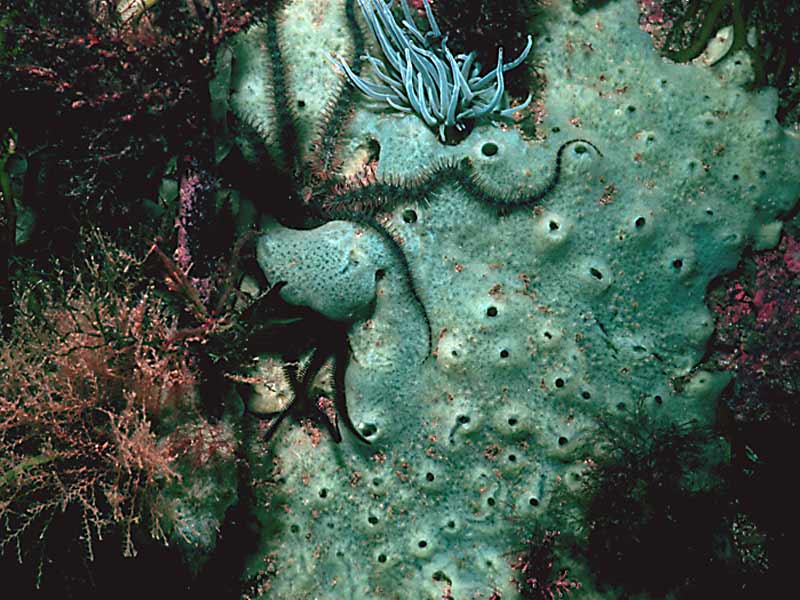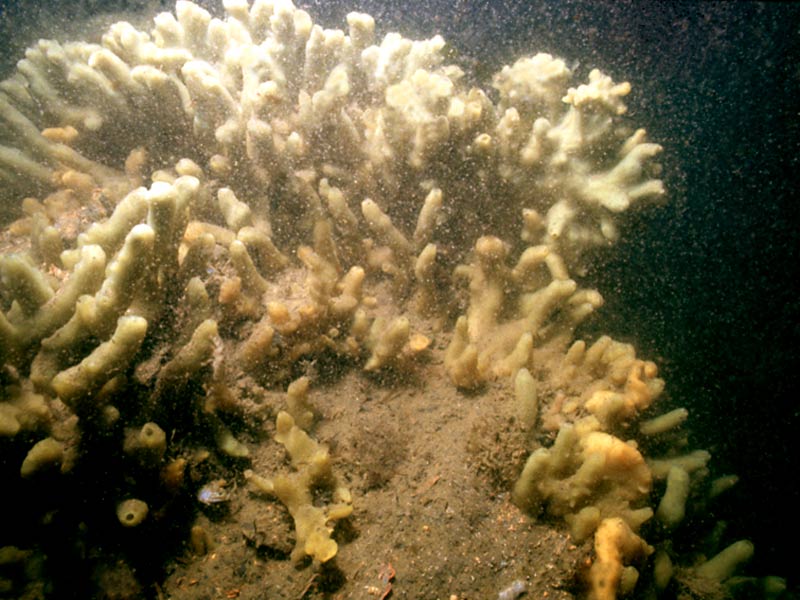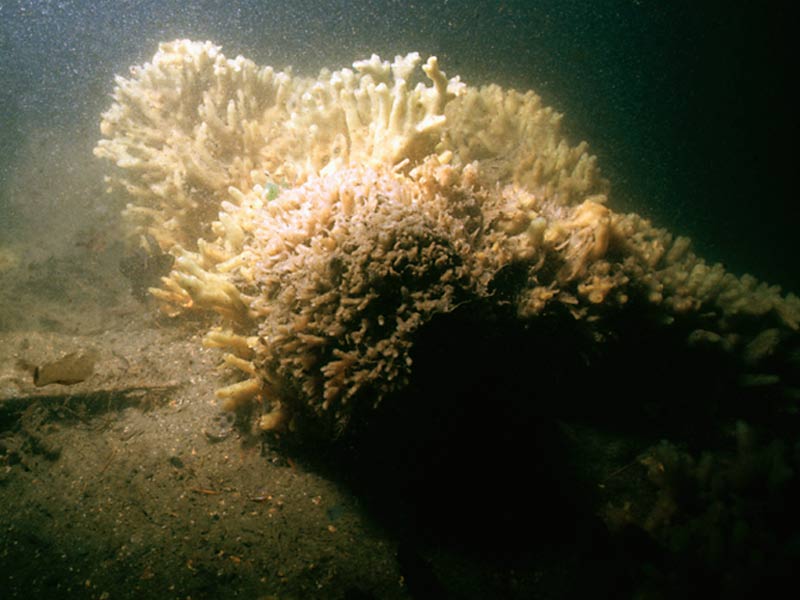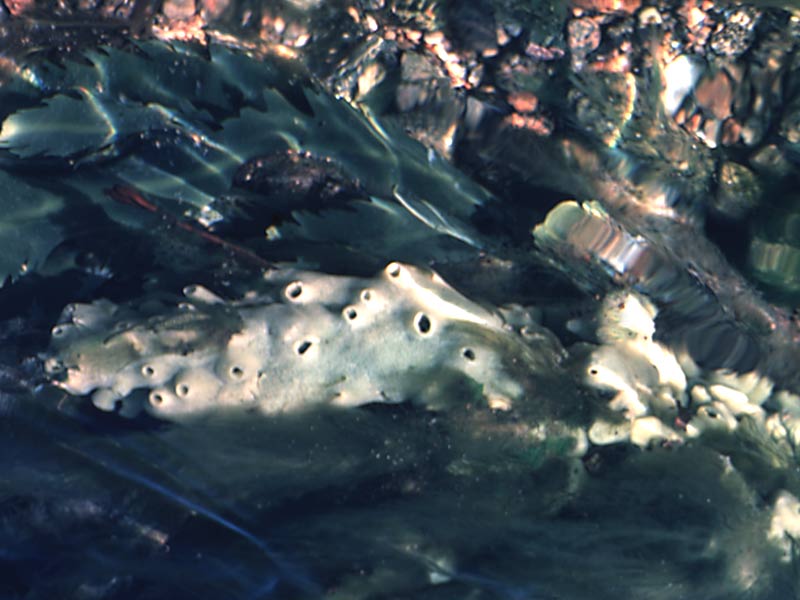Breadcrumb sponge (Halichondria (Halichondria) panicea)
Distribution data supplied by the Ocean Biodiversity Information System (OBIS). To interrogate UK data visit the NBN Atlas.Map Help
| Researched by | Dr Keith Hiscock | Refereed by | Dr Rob van Soest |
| Authority | (Pallas, 1766) | ||
| Other common names | - | Synonyms | Halichondria panicea |
Summary
Description
The morphology of Halichondria panicea can be highly variable. Most commonly found on the open coast, it can form a low crust with 'volcano' like exhalent openings (osculae). In wave sheltered areas, the species may grow into a massive form up to 20 cm thick, and in tidal rapids or sounds may be several metres across. Vethaak et al. (1982) recorded a specimen that measured ca 60 cm across and 25 cm high in the Oostershelde, although most specimens are rarely this big. Colonies are sometimes composed of connecting (anastomose) lobes or digits. On the shore and in shallow depths, it may be green due to the presence of algal symbionts in the tissue. In the shade and deeper water or in winter it is cream-yellow in colour. Halichondria panicea smells strongly of seaweed.
Recorded distribution in Britain and Ireland
Present all around Britain and Ireland.
Global distribution
Recorded in the North Atlantic from the Barents Sea to the Mediterranean but not extending far into the Baltic.
Habitat
Halichondria panicea is found in damp habitats on the shore including rock pools, under boulders and overhangs. Underwater, it is particularly abundant in wave exposed or tide-swept situations often dominating kelp stipes or Halidrys siliquosa (sea oak). In low or variable salinity, it is likely to colonize foliose red algae.
Depth range
Intertidal to ca 569 mIdentifying features
- Very variable in form.
- Usually encrusting with a smooth to slightly rough surface and prominent osculae often raised above the surface.
- Can be olive-green (with symbiotic algae), orange-yellow and winter specimens can be creamy-yellow in colour.
- The spicules are elongated, slender, spindle formed, a little curved or bent in the middle, and very gradually pointed
Additional information
Halichondria panicea occurs on kelp stipes where it may dominate in tidal rapids and on other algae such as Halidrys siliquosa (sea oak). In low or variable salinity (for instance, in the western Baltic), it may be found encrusting predominantly on red algae such as Phyllophora sp. and Phycodrys sp. (Barthel, 1988). Halichondria panicea was found growing on tunicates (especially the invasive leathery sea squirt Styela clava) and molluscs in the Oosterschelde.
Listed by
- none -
Biology review
Taxonomy
| Level | Scientific name | Common name |
|---|---|---|
| Phylum | Porifera | Sponges |
| Class | Demospongiae | Siliceous sponges |
| Order | Suberitida | |
| Family | Halichondriidae | |
| Genus | Halichondria | |
| Authority | (Pallas, 1766) | |
| Recent Synonyms | Halichondria panicea | |
Biology
| Parameter | Data | ||
|---|---|---|---|
| Typical abundance | Low density | ||
| Male size range | 5-20 cm | ||
| Male size at maturity | Data deficient | ||
| Female size range | 5-20 cm | ||
| Female size at maturity | Data deficient | ||
| Growth form | Cushion | ||
| Growth rate | See additional information | ||
| Body flexibility | None (less than 10 degrees) | ||
| Mobility | Sessile, permanent attachment | ||
| Characteristic feeding method | Active suspension feeder | ||
| Diet/food source | Omnivore, Planktotroph | ||
| Typically feeds on | Phytoplankton | ||
| Sociability | Colonial | ||
| Environmental position | Epilithic, Epiphytic | ||
| Dependency | Independent. | ||
| Supports | Host Symbiotic algae | ||
| Is the species harmful? | No | ||
Biology information
Growth rate. Under optimal conditions, Vethaak et al. (1982) recorded a mean length increase of 0.8 mm / day in summer and 0.2 mm / day in winter. It should be noted that this figure was a mean of six specimens. In terms of percentage increase in area, Barthel (1988) recorded a 1.6% increase in area per day and an increase in mean organic body mass of 100-240% between March and August in the western Baltic. Leichler & Witman (1997) recorded growth rates of about 5% per week with the highest growth rates in lower currents in the Gulf of Maine.
Growth form. Vethaak et al. (1982) described six distinct forms (as well as intermediate forms) including apparently free-living forms, low incrusting forms and massive forms with elaborate ‘chimneys’ (see Vethaak et al., 1982 for further details and photographs).
Habitat preferences
| Parameter | Data |
|---|---|
| Physiographic preferences | Enclosed coast or Embayment, Estuary, Isolated saline water (Lagoon), Open coast, Ria or Voe, Sea loch or Sea lough, Strait or Sound |
| Biological zone preferences | Lower circalittoral, Lower eulittoral, Lower infralittoral, Mid eulittoral, Sublittoral fringe, Upper circalittoral, Upper infralittoral |
| Substratum / habitat preferences | Cobbles, Large to very large boulders, Small boulders |
| Tidal strength preferences | No information |
| Wave exposure preferences | Exposed, Extremely exposed, Ultra sheltered |
| Salinity preferences | Full (30-40 psu), Reduced (18-30 psu), Variable (18-40 psu) |
| Depth range | Intertidal to ca 569 m |
| Other preferences | |
| Migration Pattern | Non-migratory or resident |
Habitat Information
Halichondria panicea occurs in the intertidal zone to over 500 m. Burton (1959, cited in Vethaak et al., 1982) considered Halichondria panicea to be cosmopolitan in its distribution. Alander (1942, cited in Vethaak et al., 1982) recorded Halichondria panicea at 569 m depth off the Swedish coast.Life history
Adult characteristics
| Parameter | Data |
|---|---|
| Reproductive type | See additional information |
| Reproductive frequency | Annual episodic |
| Fecundity (number of eggs) | No information |
| Generation time | <1 year |
| Age at maturity | No information |
| Season | April - June |
| Life span | 3-5 yrs |
Larval characteristics
| Parameter | Data |
|---|---|
| Larval/propagule type | Planula |
| Larval/juvenile development | Lecithotrophic, Ovoviviparous |
| Duration of larval stage | No information |
| Larval dispersal potential | No information |
| Larval settlement period | Insufficient information |
Life history information
Witte et al. (1994) found that Halichondria panicea had a seasonally distinct, very short, reproductive period in the Kiel Bight, Western Baltic. Oogenesis started in late summer/early autumn and oocytes developed overwinter. Spermatogenesis occurred when mature oocytes were formed and larvae were released in the spring through to June. However, Wapstra & van Soest (1987) reported that Halichondria panicea contained oocytes all year round in the Oosterschelde although embryos were only observed between May and September. They reported the species as being hermaphrodite although it was not stated whether or not the sponge was a permanent hermaphrodite or whether it exhibited protandrous or protogynous hermaphroditism. In the same area, Vethaak et al. (1982) found, comparably, that large oocytes and embryos were present from mid-May until mid-August coinciding with an increase in water temperature from 12°C to ca 19°C. Vethaak et al. (1982) also observed that, in the field, newly settled colonies were apparent within one year, i.e. the following May. Wapstra & van Soest (1987) noted that the reproductive cycle in Halichondria panicea may vary considerably between areas. A lifespan of about 3 years was suggested in Fish & Fish (1996). Unlike Halichondria bowerbanki, Halichondria panicea survive the winter in a normal, active state in the Oosterschelde (Vethaak et al., 1982).
The information in this section is taken from Wapstra & van Soest (1987) whose study focussed on demosponges from the Oosterschelde. Measurements of Halichondria panicea from the Oosterschelde revealed that larvae varied from 180 by 340 mm up to 150 by 600 mm. In general, larval were oval in shape when released. This oval form was associated with the swimming stage. Within a matter of hours, the larvae changed to a more oblong shape and this change was conducive to gliding which occurred just before settlement. Occasionally, some larvae were already oblong upon release in which case they started to glide immediately. The larvae were also found to be capable of reverting back to the oval form from the oblong form in response to disturbance although it was not stated whether continued disturbance could delay settlement. Larvae are ciliated over their entire surface and a tuft of longer cilia could be found at the posterior end. Settlement was reported to have occurred within three days of release.
Sensitivity review
The MarLIN sensitivity assessment approach used below has been superseded by the MarESA (Marine Evidence-based Sensitivity Assessment) approach (see menu). The MarLIN approach was used for assessments from 1999-2010. The MarESA approach reflects the recent conservation imperatives and terminology and is used for sensitivity assessments from 2014 onwards.
Physical pressures
Use / to open/close text displayed
| Intolerance | Recoverability | Sensitivity | Evidence / Confidence | |
Substratum loss [Show more]Substratum lossBenchmark. All of the substratum occupied by the species or biotope under consideration is removed. A single event is assumed for sensitivity assessment. Once the activity or event has stopped (or between regular events) suitable substratum remains or is deposited. Species or community recovery assumes that the substratum within the habitat preferences of the original species or community is present. Further details EvidenceVethaak et al.,(1982) recorded apparently free-living forms of Halichondria panicea rolling around on the seabed near Dogger Bank in the North Sea although it is not known whether these specimens had once been attached and survived displacement from the substratum. It is most likely that sponges attached to the substratum are unlikely to survive substratum loss. However, settlement of new colonies is likely within one year and growth rate is rapid. Therefore, intolerance and recoverability have been recorded as high. | High | High | Moderate | Moderate |
Smothering [Show more]SmotheringBenchmark. All of the population of a species or an area of a biotope is smothered by sediment to a depth of 5 cm above the substratum for one month. Impermeable materials, such as concrete, oil, or tar, are likely to have a greater effect. Further details. EvidenceIt is unlikely that Halichondria panicea will survive smothering for any significant length of time as the colony relies on water movement for respiration and has no mechanism for expanding above smothering material. Although the sponge has a mechanism for sloughing off their complete outer tissue layer together with any debris (Bartel & Wolfrath, 1989) there is probably an energetic cost in clearing sediment from tissues. Furthermore, Vethaak et al. (1982) reported that Halichondria panicea were rarely found in silt covered areas in the Oosterschelde. Therefore an intolerance of high has been recorded. However, settlement of new colonies is likely within one year and growth rate is rapid. Hence, a recoverability of high has been recorded. | High | High | Moderate | Low |
Increase in suspended sediment [Show more]Increase in suspended sedimentBenchmark. An arbitrary short-term, acute change in background suspended sediment concentration e.g., a change of 100 mg/l for one month. The resultant light attenuation effects are addressed under turbidity, and the effects of rapid settling out of suspended sediment are addressed under smothering. Further details EvidenceHalichondria panicea lives in situations such as the entrance to estuaries and in straits where suspended sediment levels and settlement of silt is often high. The sponge has a mechanism for sloughing off their complete outer tissue layer together with any debris (Bartel & Wolfrath, 1989). It is expected that the sponge can, therefore, cope with increased siltation rates and suspended sediment. However, there is probably an energetic cost in clearing sediment from tissues and therefore, an intolerance of low has been recorded. | Low | Immediate | Not sensitive | Moderate |
Decrease in suspended sediment [Show more]Decrease in suspended sedimentBenchmark. An arbitrary short-term, acute change in background suspended sediment concentration e.g., a change of 100 mg/l for one month. The resultant light attenuation effects are addressed under turbidity, and the effects of rapid settling out of suspended sediment are addressed under smothering. Further details EvidenceThe sponge may derive some benefit from organic matter as food in the suspended sediment but there is probably an energetic cost in clearing sediment from tissues. On balance, this species has been assessed as tolerant. | Tolerant | Not relevant | Not sensitive | Moderate |
Desiccation [Show more]Desiccation
EvidenceHalichondria panicea is able to withstand some desiccation, in part because the tissue holds water. However, damage may occur if desiccation levels increase from those to which established individuals are normally exposed. Bleaching and tissue death is likely at the edges of the colony but re-growth will most likely occur. | Intermediate | Very high | Low | Moderate |
Increase in emergence regime [Show more]Increase in emergence regimeBenchmark. A one hour change in the time covered or not covered by the sea for a period of one year. Further details EvidenceDesiccation is likely to be the main impact of increased emergence. Established colonies may however survive but not thrive. The sponge is able to withstand some desiccation in part because the tissue holds water. However, damage may occur if desiccation levels increase from those to which established individuals are normally exposed. Bleaching and tissue death is likely at the edges of the colony but re-growth will most likely occur. | Intermediate | Very high | Low | Low |
Decrease in emergence regime [Show more]Decrease in emergence regimeBenchmark. A one hour change in the time covered or not covered by the sea for a period of one year. Further details EvidenceThe species occurs in the subtidal so that a decrease in emergence that makes intertidal colonies subtidal will benefit the species. However, in the subtidal, colonies may be subject to greater predation and so, on balance, tolerant is suggested. | Tolerant | Not relevant | Not sensitive | Moderate |
Increase in water flow rate [Show more]Increase in water flow rateA change of two categories in water flow rate (view glossary) for 1 year, for example, from moderately strong (1-3 knots) to very weak (negligible). Further details EvidenceIn the Oosterschelde, Vethaak et al. (1982) reported that the biomass of Halichondria panicea was extremely high in stream gullies in the sublittoral associated with high water flow rates. In the case of increased water flow rates, low-lying colonies are unlikely to be adversely affected and may grow to a large size (favourable effect). However, poorly attached massive growths may be torn-off or swept away. Mortality is unlikely to be total and repair (see Bowerbank, 1857) and re-growth will occur once water flow rates return to normal. Growth is rapid (about 5% increase per week: Barthel, 1988). | Intermediate | Very high | Low | Low |
Decrease in water flow rate [Show more]Decrease in water flow rateA change of two categories in water flow rate (view glossary) for 1 year, for example, from moderately strong (1-3 knots) to very weak (negligible). Further details EvidenceA reduction in water flow rates in situations sheltered from wave action will most likely have an adverse effect on at least a proportion of colonies through reduced food supply and possible local deoxygenation. However, it is not thought that this would result in death and, therefore, an intolerance of low has been recorded. | Low | Immediate | Not sensitive | Low |
Increase in temperature [Show more]Increase in temperature
For intertidal species or communities, the range of temperatures includes the air temperature regime for that species or community. Further details EvidenceHalichondria panicea has a wide distribution in the north-east Atlantic with Britain and Ireland central to that distribution so that the species exists well-within its normal temperature survival range. | Low | Very high | Very Low | Moderate |
Decrease in temperature [Show more]Decrease in temperature
For intertidal species or communities, the range of temperatures includes the air temperature regime for that species or community. Further details EvidenceHalichondria panicea has a wide distribution in the north-east Atlantic with Britain and Ireland central to that distribution so that the species exists well-within its normal temperature survival range. However, Crisp (1964) noted that colonies were damaged by frost during the 1963/64 winter. Recovery from surviving tissue is likely to be rapid and re-colonization will occur from annual recruitment from the plankton. | Low | Very high | Very Low | Moderate |
Increase in turbidity [Show more]Increase in turbidity
EvidenceHalichondria panicea occurs in low light levels. Furthermore, Vethaak et al. (1982) reported that Halichondria panicea had much higher population densities on shaded / totally dark surfaces than on well lit ones. The symbiotic algae that occur in the tissue in intertidal and shallow subtidal situations are likely to at least decline in abundance as a result of higher turbidity levels but not affect the survival of the sponge. Overall, tolerant* has been suggested. | Tolerant* | Not relevant | Not sensitive* | Moderate |
Decrease in turbidity [Show more]Decrease in turbidity
EvidenceHalichondria panicea occurs in low light levels. The symbiotic algae that occur in the tissue in intertidal and shallow subtidal situations are likely to increase in abundance as a result of lower turbidity levels but this will not affect the survival of the sponge and tolerant has been suggested. | Tolerant | Not relevant | Not sensitive | Moderate |
Increase in wave exposure [Show more]Increase in wave exposureA change of two ranks on the wave exposure scale (view glossary) e.g., from Exposed to Extremely exposed for a period of one year. Further details EvidenceColonies of Halichondria panicea require water movement, whether wave action or tidal streams and, where wave exposure increases, some large and poorly attached colonies may be displaced by the wave action. The shape of sponge colonies is greatly influenced by the hydrodynamics of the environment and in high stress environments (such as high wave exposure), the sponges are often undersized or encrusting (Vethaak et al., 1982). Overall, intolerance has been assessed as intermediate as biomass is expected to decrease. However, the growth rate is rapid (about 5%; increase per month: Barthel 1988) and recovery would be expected to occur quickly after reversion to previous conditions. | Intermediate | Very high | Low | Moderate |
Decrease in wave exposure [Show more]Decrease in wave exposureA change of two ranks on the wave exposure scale (view glossary) e.g., from Exposed to Extremely exposed for a period of one year. Further details EvidenceColonies of Halichondria panicea require water movement, whether wave action or tidal streams. Reduction in wave exposure at sites where tidal streams are slight or absent may result in at least a reduction in growth and therefore an intolerance of low is suggested. | Low | Very high | Very Low | Moderate |
Noise [Show more]Noise
EvidenceSponges have no known receptors for noise. | Tolerant | Not relevant | Not sensitive | High |
Visual presence [Show more]Visual presenceBenchmark. The continuous presence for one month of moving objects not naturally found in the marine environment (e.g., boats, machinery, and humans) within the visual envelope of the species or community under consideration. Further details EvidenceSponges have no known visual receptors. | Tolerant | Not relevant | Not sensitive | High |
Abrasion & physical disturbance [Show more]Abrasion & physical disturbanceBenchmark. Force equivalent to a standard scallop dredge landing on or being dragged across the organism. A single event is assumed for assessment. This factor includes mechanical interference, crushing, physical blows against, or rubbing and erosion of the organism or habitat of interest. Where trampling is relevant, the evidence and trampling intensity will be reported in the rationale. Further details. EvidenceThe sponge is attached to the substratum and is unlikely to survive abrasion and physical disturbance. Therefore, an intolerance of intermediate is suggested. However, where merely damaged, repair occurs very rapidly (Bowerbank, 1857) whilst the settlement of new colonies is likely within one year and the growth rate is rapid. Sponges may also regrow from tissue remaining in crevices or other irregularities and that were not affected by the abrasion. | Intermediate | High | Low | Moderate |
Displacement [Show more]DisplacementBenchmark. Removal of the organism from the substratum and displacement from its original position onto a suitable substratum. A single event is assumed for assessment. Further details EvidenceThe sponge is attached to the substratum and is unlikely to survive being detached and displaced even though it remains in the area unless the location is very sheltered from disturbing conditions such as wave action. However, settlement of new colonies is likely within one year and growth rate is rapid. Sponges may also regrow from tissue remaining in crevices or other irregularities and that were not affected by the displacement. | High | High | Moderate | High |
Chemical pressures
Use [show more] / [show less] to open/close text displayed
| Intolerance | Recoverability | Sensitivity | Evidence / Confidence | |
Synthetic compound contamination [Show more]Synthetic compound contaminationSensitivity is assessed against the available evidence for the effects of contaminants on the species (or closely related species at low confidence) or community of interest. For example:
The evidence used is stated in the rationale. Where the assessment can be based on a known activity then this is stated. The tolerance to contaminants of species of interest will be included in the rationale when available; together with relevant supporting material. Further details. EvidenceInsufficient | No information | Not relevant | No information | Not relevant |
Heavy metal contamination [Show more]Heavy metal contaminationEvidenceInsufficient | No information | Not relevant | No information | Not relevant |
Hydrocarbon contamination [Show more]Hydrocarbon contaminationEvidenceVery little information has been found. It appears that Halichondria panicea survived in areas affected by the Torrey Canyon oil spill (Smith, 1968), although few observations were made. If mortality occurred, settlement of new colonies is likely within one year and growth rate is rapid. | Low | High | Low | Very low |
Radionuclide contamination [Show more]Radionuclide contaminationEvidenceInsufficient | No information | Not relevant | No information | Not relevant |
Changes in nutrient levels [Show more]Changes in nutrient levelsEvidenceInsufficient | No information | Not relevant | No information | Not relevant |
Increase in salinity [Show more]Increase in salinity
EvidenceHalichondria panicea is euryhaline, occurring from full to low salinity conditions. Although it was not found in a mesohaline (5-18) lagoon in the Oosterschelde, it did survive in a polyhaline (18-30) lagoon, albeit as a thin encrusting base (the effects of the siltation were thought to be responsible for this as opposed to the reduced salinity conditions). Settlement of new colonies is likely within one year and the growth rate is rapid. | Low | High | Low | Moderate |
Decrease in salinity [Show more]Decrease in salinity
EvidenceHalichondria panicea occurs from full to low salinity conditions and only prolonged exposure to fresh or almost fresh water is likely to result in mortality. Settlement of new colonies is likely within one year and growth rate is rapid. | Low | High | Low | Moderate |
Changes in oxygenation [Show more]Changes in oxygenationBenchmark. Exposure to a dissolved oxygen concentration of 2 mg/l for one week. Further details. EvidenceHalichondria panicea lives in areas of flowing water, which suggests that it is likely to need a good supply of oxygen for survival. Cole et al. (1999) suggest possible adverse effects on marine species below 4 mg/l and probable adverse effects below 2 mg/l. However, no information was found concerning the tolerance of Halichondria panicea to changes in oxygenation. Settlement of new colonies is likely within one year and the growth rate is rapid. | Intermediate | High | Low | Very low |
Biological pressures
Use [show more] / [show less] to open/close text displayed
| Intolerance | Recoverability | Sensitivity | Evidence / Confidence | |
Introduction of microbial pathogens/parasites [Show more]Introduction of microbial pathogens/parasitesBenchmark. Sensitivity can only be assessed relative to a known, named disease, likely to cause partial loss of a species population or community. Further details. EvidenceNo literature was found concerning diseases and parasites in Halichondria panicea. The sponge has a mechanism for sloughing off the outer tissue layer (Bartel & Wolfrath, 1989) which may also be a means of removing pathogens or epizooites. | No information | No information | No information | Not relevant |
Introduction of non-native species [Show more]Introduction of non-native speciesSensitivity assessed against the likely effect of the introduction of alien or non-native species in Britain or Ireland. Further details. EvidenceInsufficient | No information | No information | No information | Not relevant |
Extraction of this species [Show more]Extraction of this speciesBenchmark. Extraction removes 50% of the species or community from the area under consideration. Sensitivity will be assessed as 'intermediate'. The habitat remains intact or recovers rapidly. Any effects of the extraction process on the habitat itself are addressed under other factors, e.g. displacement, abrasion and physical disturbance, and substratum loss. Further details. EvidenceNo targeted extraction of this species is known. Were it to be extracted, it is expected that tissue would be left behind and would regrow. Growth rates of about 5% per week are likely (Barthel, 1988). | Not relevant | No information | Not relevant | Not relevant |
Extraction of other species [Show more]Extraction of other speciesBenchmark. A species that is a required host or prey for the species under consideration (and assuming that no alternative host exists) or a keystone species in a biotope is removed. Any effects of the extraction process on the habitat itself are addressed under other factors, e.g. displacement, abrasion and physical disturbance, and substratum loss. Further details. EvidenceHalichondria panicea colonizes Laminaria hyperborea stipes and may thus be subject to harvesting effects. Sivertsen (1991; cited in Birkett et al., 1998) showed that kelp populations stabilise after about 4-5 year post-harvesting and Halichondria panicea will settle readily so that recovery is likely to occur within a year or possibly more. | High | High | Moderate | High |
Additional information
Importance review
Policy/legislation
- no data -
Status
| National (GB) importance | - | Global red list (IUCN) category | - |
Non-native
| Parameter | Data |
|---|---|
| Native | Native |
| Origin | - |
| Date Arrived | - |
Importance information
Halichondria panicea is likely to dominate hard substratum sublittoral habitats where tidal streams are very strong in wave sheltered conditions. Halichondria panicea is preyed on by sea slugs, e.g. Archidoris pseudoargus (Picton & Morrow, 1994).Bibliography
Alander, H., 1942. Sponges from the Swedish West-coast and adjacent waters. Göteborg: Struves.
Barnes, R.D., 1980. Invertebrate Zoology, 4th ed. Philadelphia: Holt-Saunders International Editions.
Barthel, D. & Wolfrath, B., 1989. Tissue sloughing in the sponge Halichondria panicea: a fouling organism prevents being fouled. Oecologia, 78, 357-360.
Barthel, D., 1988. On the ecophysiology of the sponge Halichondria panicea in Kiel Bight. II. Biomass, production, energy budget and integration in environmental processes. Marine Ecology Progress Series, 43, 87-93.
Birkett, D.A., Maggs, C.A., Dring, M.J. & Boaden, P.J.S., 1998b. Infralittoral reef biotopes with kelp species: an overview of dynamic and sensitivity characteristics for conservation management of marine SACs. Natura 2000 report prepared by Scottish Association of Marine Science (SAMS) for the UK Marine SACs Project., Scottish Association for Marine Science. (UK Marine SACs Project, vol VI.), 174 pp. Available from: http://ukmpa.marinebiodiversity.org/uk_sacs/pdfs/reefkelp.pdf
Burton, M., 1959. Spongia. Zoology Iceland, 2, 1-71.
Campbell, A., 1994. Seashores and shallow seas of Britain and Europe. London: Hamlyn.
Cole, S., Codling, I.D., Parr, W. & Zabel, T., 1999. Guidelines for managing water quality impacts within UK European Marine sites. Natura 2000 report prepared for the UK Marine SACs Project. 441 pp., Swindon: Water Research Council on behalf of EN, SNH, CCW, JNCC, SAMS and EHS. [UK Marine SACs Project.]. Available from: http://ukmpa.marinebiodiversity.org/uk_sacs/pdfs/water_quality.pdf
Crisp, D.J. (ed.), 1964. The effects of the severe winter of 1962-63 on marine life in Britain. Journal of Animal Ecology, 33, 165-210.
Fish, J.D. & Fish, S., 1996. A student's guide to the seashore. Cambridge: Cambridge University Press.
Hayward, P.J. & Ryland, J.S. 1990. The marine fauna of the British Isles and north-west Europe. Oxford: Oxford University Press.
Leichler, J.J. & Witman, J.D. 1997. Water flow rates over subtidal rock walls: relation to distributions and growth rates of sessile suspension feeders in the Gulf of Maine. Water flow and growth rates. Journal of Experimental Marine Biology and Ecology, 209, 293-307.
Picton, B. E. & Morrow, C.C., 1994. A Field Guide to the Nudibranchs of the British Isles. London: Immel Publishing Ltd.
Smith, J.E. (ed.), 1968. 'Torrey Canyon'. Pollution and marine life. Cambridge: Cambridge University Press.
Vethaak, A.D., Cronie, R.J.A. & van Soest, R.W.M., 1982. Ecology and distribution of two sympatric, closely related sponge species, Halichondria panicea (Pallas, 1766) and H. bowerbanki Burton, 1930 (Porifera, Demospongiae), with remarks on their speciation. Bijdragen tot de Dierkunde, 52, 82-102.
Wapstra, M. & van Soest, R.W.M., 1987. Sexual reproduction, larval morphology and behaviour in demosponges from the southwest of the Netherlands. Berlin: Springer-Verlag.
Wilson, H.V., 1935. Some critical points in the metamorphosis of the halichondrine sponge larva. Journal of Morphology, 58, 285-354.
Witte, U., Bartel, D. & Tendal, O., 1994. The reproductive cycle of the sponge Halichondria panicea Pallas (1766) and its relationship to temperature and salinity. Journal of Experimental Marine Biology and Ecology, 183, 42-52.
Datasets
Centre for Environmental Data and Recording, 2018. Ulster Museum Marine Surveys of Northern Ireland Coastal Waters. Occurrence dataset https://www.nmni.com/CEDaR/CEDaR-Centre-for-Environmental-Data-and-Recording.aspx accessed via NBNAtlas.org on 2018-09-25.
Cofnod – North Wales Environmental Information Service, 2018. Miscellaneous records held on the Cofnod database. Occurrence dataset: https://doi.org/10.15468/hcgqsi accessed via GBIF.org on 2018-09-25.
Environmental Records Information Centre North East, 2018. ERIC NE Combined dataset to 2017. Occurrence dataset: http://www.ericnortheast.org.ukl accessed via NBNAtlas.org on 2018-09-38
Fife Nature Records Centre, 2018. St Andrews BioBlitz 2014. Occurrence dataset: https://doi.org/10.15468/erweal accessed via GBIF.org on 2018-09-27.
Fife Nature Records Centre, 2018. St Andrews BioBlitz 2016. Occurrence dataset: https://doi.org/10.15468/146yiz accessed via GBIF.org on 2018-09-27.
Kent Wildlife Trust, 2018. Biological survey of the intertidal chalk reefs between Folkestone Warren and Kingsdown, Kent 2009-2011. Occurrence dataset: https://www.kentwildlifetrust.org.uk/ accessed via NBNAtlas.org on 2018-10-01.
Kent Wildlife Trust, 2018. Kent Wildlife Trust Shoresearch Intertidal Survey 2004 onwards. Occurrence dataset: https://www.kentwildlifetrust.org.uk/ accessed via NBNAtlas.org on 2018-10-01.
Manx Biological Recording Partnership, 2017. Isle of Man wildlife records from 01/01/2000 to 13/02/2017. Occurrence dataset: https://doi.org/10.15468/mopwow accessed via GBIF.org on 2018-10-01.
Manx Biological Recording Partnership, 2018. Isle of Man historical wildlife records 1990 to 1994. Occurrence dataset: https://doi.org/10.15468/aru16v accessed via GBIF.org on 2018-10-01.
Manx Biological Recording Partnership, 2018. Isle of Man historical wildlife records 1995 to 1999. Occurrence dataset: https://doi.org/10.15468/lo2tge accessed via GBIF.org on 2018-10-01.
Manx Biological Recording Partnership, 2022. Isle of Man historical wildlife records 1990 to 1994. Occurrence dataset:https://doi.org/10.15468/aru16v accessed via GBIF.org on 2024-09-27.
Merseyside BioBank., 2018. Merseyside BioBank (unverified). Occurrence dataset: https://doi.org/10.15468/iou2ld accessed via GBIF.org on 2018-10-01.
National Trust, 2017. National Trust Species Records. Occurrence dataset: https://doi.org/10.15468/opc6g1 accessed via GBIF.org on 2018-10-01.
NBN (National Biodiversity Network) Atlas. Available from: https://www.nbnatlas.org.
Norfolk Biodiversity Information Service, 2017. NBIS Records to December 2016. Occurrence dataset: https://doi.org/10.15468/jca5lo accessed via GBIF.org on 2018-10-01.
OBIS (Ocean Biodiversity Information System), 2025. Global map of species distribution using gridded data. Available from: Ocean Biogeographic Information System. www.iobis.org. Accessed: 2025-08-14
Outer Hebrides Biological Recording, 2018. Invertebrates (except insects), Outer Hebrides. Occurrence dataset: https://doi.org/10.15468/hpavud accessed via GBIF.org on 2018-10-01.
South East Wales Biodiversity Records Centre, 2023. SEWBReC Marine and other Aquatic Invertebrates (South East Wales). Occurrence dataset:https://doi.org/10.15468/zxy1n6 accessed via GBIF.org on 2024-09-27.
Suffolk Biodiversity Information Service., 2017. Suffolk Biodiversity Information Service (SBIS) Dataset. Occurrence dataset: https://doi.org/10.15468/ab4vwo accessed via GBIF.org on 2018-10-02.
Yorkshire Wildlife Trust, 2018. Yorkshire Wildlife Trust Shoresearch. Occurrence dataset: https://doi.org/10.15468/1nw3ch accessed via GBIF.org on 2018-10-02.
Citation
This review can be cited as:
Last Updated: 29/04/2008

